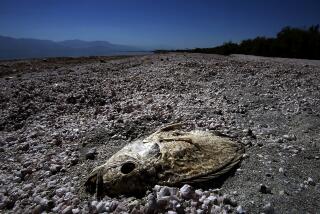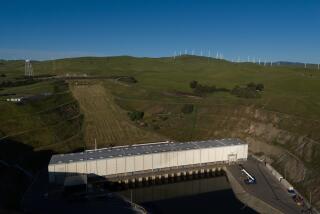THE OUTDOORS : From Sink to Shining Sea : Formed on Ancient Sea Bed, Salton Sea Is Fishing Hot Spot
NILAND, Calif. — It was still some time before dawn, but sunshine was already on the water of the Salton Sea. Sunshine George Lening, considered one of the better fishing guides here, needed to pilot his boat only a short distance from the Red Hill launch ramp before finding what he was looking for.
Croaker were smacking at the small tilapia schooling on the sea’s glassy surface, lighted somewhat by a full moon. Birds, mostly gulls, flew overhead, diving for their share of the tilapia. Larger fish were swirling about the surface, feeding on both croaker and tilapia.
Lening knew he had found a good spot.
His six passengers promptly cast their small tilapia minnows--considered the best bait--into the coffee brown water. Within minutes, a line went screaming from a passenger’s spinning reel. It was a hard strike, but Mary Jane Thomas of Corona handled the situation well, keeping her line tight and her composure intact while being pulled up and down the boat’s rail.
After about five minutes, Thomas had landed a 15-pound orangemouth corvina. The previous week she had caught a 25-pounder on a trip during which 7 anglers caught 31 fish, the smallest weighing 17 pounds.
It was business as usual on the Salton Sea, Southern California’s inland saltwater lake.
By the time the sun rose above the desert floor, most of the anglers aboard Lening’s 30-foot pontoon boat had boated fish of their own, and there would be plenty more netted before the noon quitting time. Each of the corvina weighed more than 14 pounds. The fishermen used 5- to 6-foot rods and 10- to 15-pound test line.
“About 80% of my business is repeat business,” said Lening, who runs trips from February through July. The reason is clear.
“There’s no place else you can catch this many fish,” said Thom Masters, one of Lening’s many regulars. “You can catch bigger fish in the ocean, but you can also catch nothing.”
Catching nothing in the Salton Sea is practically unheard of during June and July, when the corvina are literally there for the taking.
Crowds are down, too, since the sun unforgivingly bakes anglers to various shades of red. Temperatures here during the summer almost always reach well in excess of 100 degrees. And unlike many pontoon boats, Lening’s is not equipped with a canvas top.
“You get used to it,” was the basic response to the heat. Dripping sweat was the eventual reaction.
But if summertime fishermen here are a hardy bunch, which they appear to be, then so are the fish, which seem more plentiful and are certainly bigger, averaging between 15 and 20 pounds, than those caught during the spring and fall, when they average 4 to 10 pounds. The record, caught during the summer, is 36 1/2 pounds.
“During the normal months, I call this fishing,” Lening said after the first few fish had been landed. “But during June and July, I call it taking.”
Lening, 50, has five years of experience as a Salton Sea fishing guide.
The Salton Sea, 35 miles long and 9 to 12 miles wide, is indeed one of the most productive fisheries in California, and could very well be the best.
Glenn Black, a biologist for the Department of Fish and Game and a Salton Sea specialist, said: “An angler catches an average of 1 1/2 fish per hour. That’s an excellent ratio. Very few areas in the state (marine included) even come close to that.”
And those figures are based on year-round catches. Lening says that during June and July, his customers often catch their nine-fish limits faster than a car can overheat on the nearby desert highways.
“Last week I had a group of nine anglers who caught 150 fish before noon,” he said. “Each had his limit on the boat within the first couple of hours, and they spent the rest of the day releasing fish.”
The flesh of an orangemouth corvina is considered excellent in taste, but anglers might want to practice catch-and-release nevertheless.
The reason? High levels of selenium, a sulfurous element. The Department of Health Services warns that women of child-bearing age and children under 16 should not eat selenium-tainted fish at all, and others should eat no more than four ounces within a two-week period.
Said Masters: “Still, nothing can compare to this.”
The Salton Sea was formed in 1905, when efforts to irrigate the Imperial Valley with Colorado River water resulted in the flooding of the basin formerly known as the Salton Sink, an ancient sea bed.
The sea gets its water now from drainage in the Imperial and Coachella irrigation districts, which tap the Colorado. Because the land in the area being irrigated is naturally salty, however, the water entering the sea has picked up salt, constantly adding to the salinity of the sea.
A condensed history of the Salton Sea as a fishery:
--Trout and carp were the first modern-day inhabitants of the sea as they entered with the flood waters of the Colorado River. They soon died off, however, as salt levels increased because of rapid evaporation caused by the heat.
--In the 1920s, mullet entered the sea from the Gulf of California via the Colorado River and a commercial fishery was developed. The damming of the river, however, blocked the mullets’ passage and the remaining fish--mullet were unable to reproduce in the highly saline water--were eventually fished out.
--In the 1950s, the DFG sent a team of marine biologists to San Felipe, Mexico, with tank trucks. The team caught 30 species of saltwater fish, ranging from the small anchovy to the large totuava--a member of the croaker family similar to the orangemouth corvina--and a sport fishery was developed in 1958. Only the orangemouth corvina, the sargo and croaker survived.
--In the late 1960s, tilapia were introduced from Africa and Israel when the irrigation districts requested help in controlling aquatic weed growth. The tilapia, it was hoped, would travel the irrigation canals and keep the unwanted growth down. It was first believed that the tilapia would not be able to adapt in the Salton Sea, but the small bluegill-type fish has survived and become the most abundant fish in the sea.
The future, however, looks bleak for this sportsman’s paradise--the surrounding area also sports one of California’s busiest duck hunting areas--since the ever-increasing salinity imperils both the fishery, and possibly the more than 100 species of aquatic birds that use the sea and surrounding wetlands.
Currently, the Salton Sea has a salinity level of about 40 parts per thousand, according to Black. The ocean has 33 parts per thousand.
“The level will raise to a point where the fish will not be able to reproduce successfully,” Black said, adding that it would have to reach somewhere between 40 and 45 parts per thousand before the fish become threatened.
“It is a foregone conclusion,” Black said. “But nobody knows just when.
“If the fish die, the birds will also be in danger. They will have to find someplace else, if that’s even possible.”
State and resource agencies have recently put together a Salton Sea task force whose goal is to remove some salt from the sea, and the DFG is financing other studies that will gather biological data to help the task force.
Though the group’s report won’t be available for a few months, Black said that one plan involves the building of diked evaporation ponds, which would be flooded with sea water, then allowed to collect the remaining salt. The sea would then be diluted somewhat by the less salty irrigation waters.
Other firms have been contracted for various studies aimed at saving the fishery, but no one can say for sure that these attempts will be successful.
One angler offered this bit of advice: “Tell them (fishermen) to get it while it’s hot.”
More to Read
Sign up for The Wild
We’ll help you find the best places to hike, bike and run, as well as the perfect silent spots for meditation and yoga.
You may occasionally receive promotional content from the Los Angeles Times.






